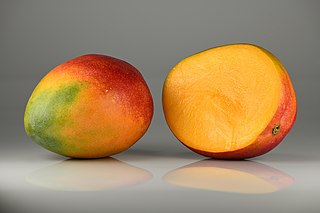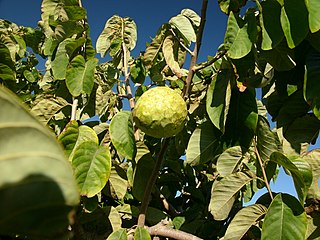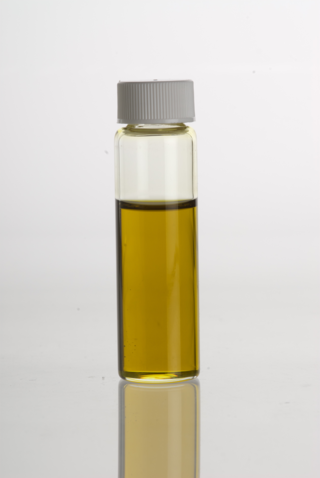
A mango is an edible stone fruit produced by the tropical tree Mangifera indica. It originated from the region between northwestern Myanmar, Bangladesh, and northeastern India. M. indica has been cultivated in South and Southeast Asia since ancient times resulting in two types of modern mango cultivars: the "Indian type" and the "Southeast Asian type". Other species in the genus Mangifera also produce edible fruits that are also called "mangoes", the majority of which are found in the Malesian ecoregion.

The paprika or bell pepper is the fruit of plants in the Grossum Group of the species Capsicum annuum. Cultivars of the plant produce fruits in different colors, including red, yellow, orange, green, white, chocolate, candy cane striped, and purple. Bell peppers are sometimes grouped with less pungent chili varieties as "sweet peppers". While they are botanically fruits—classified as berries—they are commonly used as a vegetable ingredient or side dish. Other varieties of the genus Capsicum are categorized as chili peppers when they are cultivated for their pungency, including some varieties of Capsicum annuum.

Pollination of fruit trees is required to produce seeds with surrounding fruit. It is the process of moving pollen from the anther to the stigma, either in the same flower or in another flower. Some tree species, including many fruit trees, do not produce fruit from self-pollination, so pollinizer trees are planted in orchards.

Guacamole is an avocado-based dip, spread, or salad first developed in Mexico. In addition to its use in modern Mexican cuisine, it has become part of international cuisine as a dip, condiment, and salad ingredient.

The loquat is a large evergreen shrub or tree grown commercially for its orange fruit. It is also cultivated as an ornamental plant.

The cherimoya, also spelled chirimoya and called chirimuya by the Inca people, is a species of edible fruit-bearing plant in the genus Annona, from the family Annonaceae, which includes the closely related sweetsop and soursop. The plant has long been believed to be native to Ecuador and Peru, with cultivation practised in the Andes and Central America, although a recent hypothesis postulates Central America as the origin instead, because many of the plant's wild relatives occur in this area.

Persea is a genus of about 150 species of evergreen trees belonging to the laurel family, Lauraceae. The best-known member of the genus is the avocado, P. americana, widely cultivated in subtropical regions for its large, edible fruit.

The tamarillo is a tree or shrub in the flowering plant family Solanaceae. It bears the tamarillo, an egg-shaped edible fruit. It is also known as the tree tomato, tomate de árbol, tomate andino, tomate serrano, blood fruit, poor man's tomato, tomate de yuca, tomate de españa, sachatomate, berenjena, chilto and tamamoro in South America, tyamtar, rambheda or rukh tamatar in Nepal, and terong Belanda in Indonesia. It is popular globally, especially in Peru, Colombia, New Zealand, Ecuador, Nepal, Rwanda, Burundi, Australia, and Bhutan.
Florida Lime & Avocado Growers, Inc. v. Paul, 373 U.S. 132 (1963), was a 1963 decision of the United States Supreme Court in which the Court declined to invalidate a California law that imposed minimum fat content standards on avocados sold in the state, including those imported from other states. The law prohibited the sale of avocados that did not contain at least 8% oil by weight. Florida, a major avocado producer, employed, for wholesale marketing purposes, a federal standard unrelated to oil content. Most Florida avocados that were marketable at home failed to meet the California standard, because they were a different variety from those sold in California, with a lower fat content. Accordingly, Florida avocado growers brought this suit, arguing (unsuccessfully) that the California law (1) was preempted by federal law, (2) violated equal protection, and (3) unduly burdened and interfered with their right to engage in interstate commerce. The case is widely used in law school casebooks on constitutional law and federal jurisdiction as illustrative of preemption issues.

The Hass avocado is a variety of avocado with dark green, bumpy skin. It was first grown and sold by Southern California mail carrier and amateur horticulturist Rudolph Hass, who also gave it his name.

Avocado oil is an edible oil extracted from the pulp of avocados, the fruit of Persea americana. It is used as an edible oil both raw and for cooking, where it is noted for its high smoke point. It is also used for lubrication and in cosmetics.

Persea schiedeana, the coyo, is an endangered, evergreen tree in the laurel family (Lauraceae), native to tropical forests of southern Mexico and Central America. Its edible fruit resembles that of the avocado, a related tree in the genus Persea. Other common names include aguacate de montaña, aguacatón, chinini, chupte and yas.
Pseudocercospora purpurea is a fungal plant pathogen that causes a leaf spot on the avocado. Species Cercospora purpurea was originally found on the leaves of Persea species in Georgia, USA in 1878. before the species was transferred to the Pseudocercospora genus in 1976.
Sphaceloma perseae is a plant-pathogenic fungus in the division Ascomycota. It infects the avocado plant, a tree native to Central America and Mexico. Currently there are three cultivars of avocados in large-scale agricultural production: Guatemalan, Mexican, and West Indian. The pathogen is currently limited to the P. Americana species but is able to infect all three cultivars. The resulting disease is known as avocado scab for the symptoms which are present on the fruit of the avocado tree. It is believed that the disease developed in Florida in the early twentieth century and is related to citrus scab, Elsinoe fawcetti. Since then, S.perseae has spread to many regions worldwide that support cultivation of the avocado tree. This pathogen threatens the global avocado market, including both importers and exporters of the crop. Countries which import avocados, including the United States, have experienced a rising demand over the past decade which is projected to continue for years to come. An understanding of avocado scab characteristics and feasible prevention methods is essential to maintenance of cultures and economies influenced by the avocado fruit.
Rudolph Gustav Hass was an American mail carrier and amateur horticulturist who first grew the Hass avocado, the source of 95% of California avocados grown commercially today.
The 'Lula' avocado is an avocado cultivar that originated in South Florida.
The Monroe avocado is a commercial named cultivar of avocado that originated in south Florida.

Avocado production is important to the economy of Mexico with the country being the world's largest producer of the crop. Mexico supplies 45 percent of the international avocado market. Of the 57 avocado producing countries, the other major producers are Colombia, Peru, Dominican Republic, and Kenya, in that order.
Calavo Growers, Inc., is an international consumer goods and farm products company. The company packages, and distributes avocados and other fruits, as well as their fresh prepared food to restaurants, stores, and individual customers worldwide. While the company is based in Santa Paula, California, avocado production is cultivated throughout the state of California, as well as Central and South America. Calavo Growers was established in 1924 as an agricultural cooperative and was instrumental in launching the California avocado industry. The company operates its business through three divisions including Fresh Products, Calavo Foods and Renaissance Food Group (RFG). The company has been listed on the America's Best Small Company list by Forbes in 2013.

Maluma is a commercial cultivar of avocado that was discovered in South Africa. It is marketed simply as 'Maluma', but sometimes also as 'Maluma Hass', referring to its similarity in appearance to the well-known Hass cultivar. Its name originated from the fact that it was discovered by Mr. Dries Joubert, a farmer from Levubu in South Africa, on his farm 'Maluma'.



































